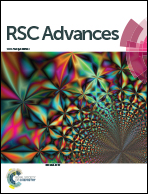A series of planar tetranuclear lanthanide complexes: axial ligand modulated magnetic dynamics in Dy4 species†
Abstract
Ten new lanthanide compounds were successfully obtained based on an 8-hydroxyquinoline Schiff base derivative and β-diketonates with different substituent groups, namely, [Ln4(μ3-OH)2L6(acac)4]·2.5CH3CN (Ln = Gd (1), Tb (2), Dy (3), Ho (4) and Yb (5); HL = 5-(4-methoxybenzylidene)-8-hydroxylquinoline; Hacac = acetylacetone), [Ln4(μ3-OH)2L6(tmhd)4]·xCH3CN·yCH3CH2OH (Ln = Eu (6), Gd (7), and Tb (8), x = 1, y = 1; Ln = Dy (9), x = 2, y = 0; Htmhd = 2,2,6,6-tetramethyl-3,5-heptanedione) and [Dy4(μ3-OH)2L6(beac)4]·CH3CN (10) (Hbeac = 1-benzoylacetone). Single crystal X-ray diffraction revealed that compounds 1–10 all contain planar tetranuclear lanthanide centers with a similar butterfly-shape arrangement, and each lanthanide ion is located in a distorted bicapped trigonal prism coordination sphere. 1·Gd and 7·Gd exhibit magnetic refrigeration behavior with the maximum values of −ΔSm being 19.39(2) and 16.21(3) J K−1 kg−1, respectively. Additionally, the effects of steric-hindrance on the magnetic anisotropy of the Dy3+ centers in 3·Dy, 9·Dy and 10·Dy were observed through comparative studies on their magnetic behaviors, which showed different SMM behaviors with energy barriers of 99.29(3) K for 3·Dy, 64.56(4) K for 9·Dy and 61.05(0) K for 10·Dy.



 Please wait while we load your content...
Please wait while we load your content...